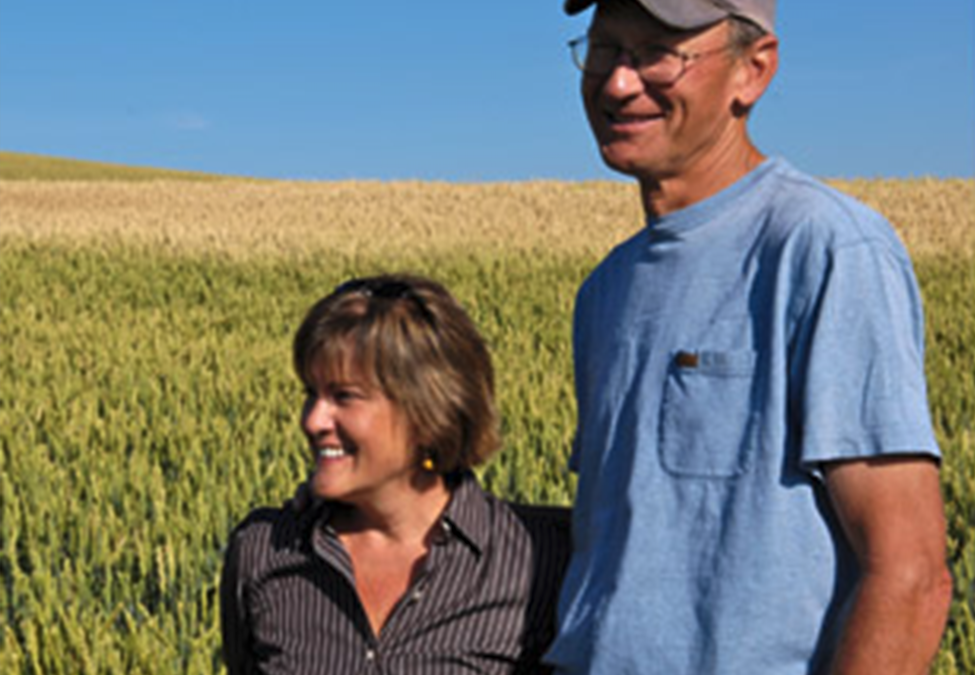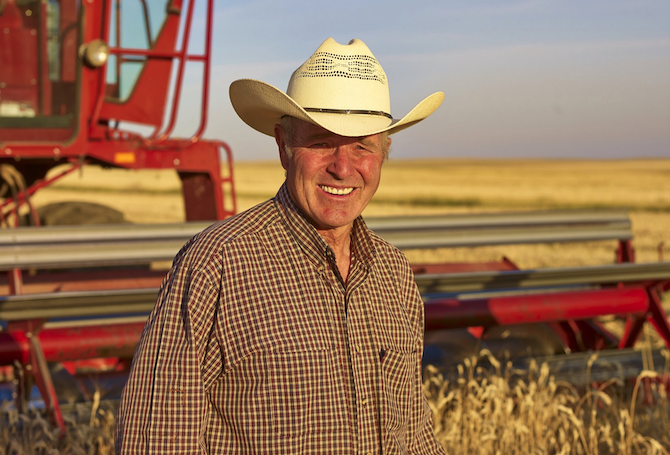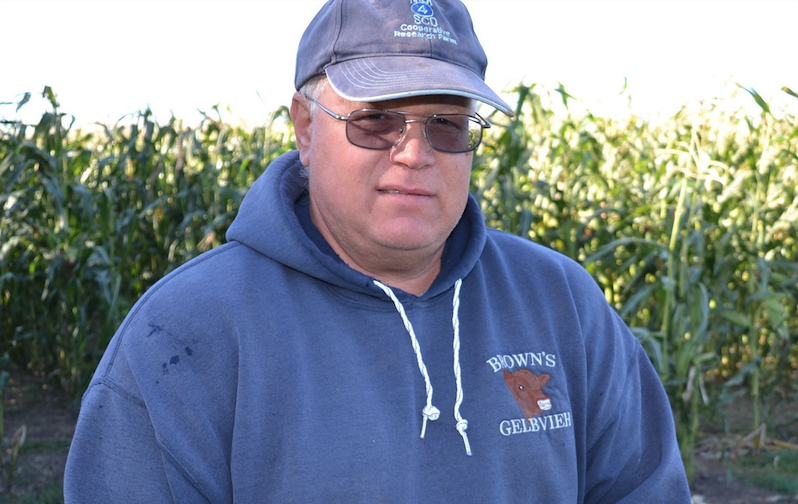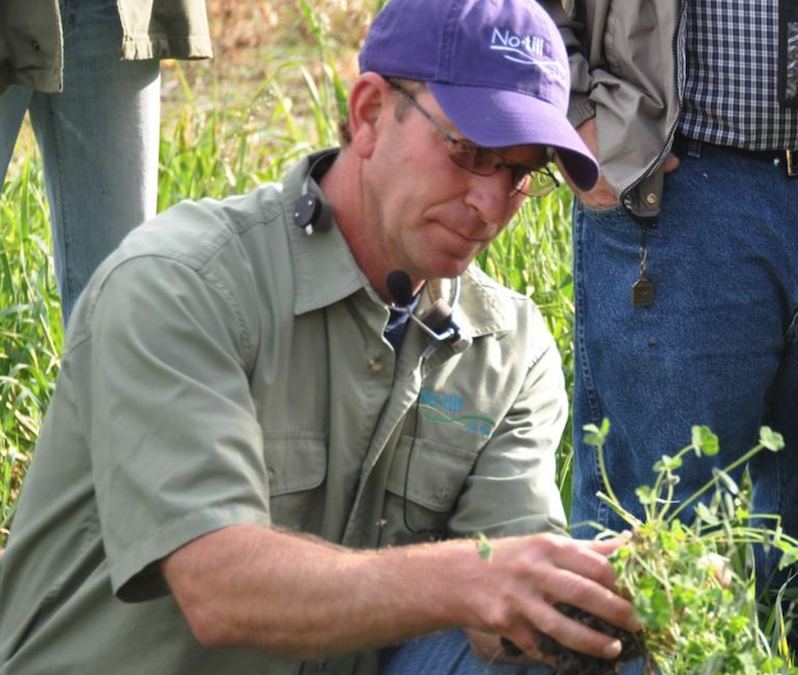
Zenner Family Farms
Zenner Family Farms
Russ and Cathy Zenner, Zenner Family Farms, Genesee, Idaho. Credit: Russ Zenner.
“
Russ & Kathy Zenner
Zenner Family Farms
Northwest Region | Genesee, ID
Main Product: Grains
Scale: 2800 acres under management
Increase crop diversity, add dynamic rotation, integrate livestock and intensive grazing of cover crops.
Story featured in Resilient Agriculture (1st Edition)
Other Resilience Stories About This Farm
2022 Governor’s Award for Excellence in Agriculture, Environmental Stewardship: Russ Zenner
The Problem with Wetter Springs
Adapting No-Till In the Palouse With Russ Zenner (podcast)
Ag Media Summit: 2 farmers find ways to thrive in tough terrain
Tales from the Farm: Zenner Family Farm | Genesee, Idaho
This story based on a 2013 interview, with a 2021 update.
Russ and Kathy Zenner have been farming in the Palouse Region of Idaho near the Washington–Idaho border in Genesee for more than forty years. Located about a hundred miles south of Spokane, WA, Zenner Family Farms includes ground that was first farmed by Russ’ grandfather in 1935. Kathy and Russ joined the family business in 1970 and took over management of the farm fourteen years later. In 2012, Russ’s cousin Clint Zenner and his wife Alicia took on some management responsibilities, becoming the fourth generation to carry on the farming tradition of the Zenner Family in Idaho.
The Palouse is a unique region of steep rolling hills in eastern Washington and western Idaho. The rich soils and winter rains produce some of the highest dryland wheat yields in the nation. But the topography, winter rains and intensive tillage typical of past wheat production also produced some of the worst soil erosion in the nation — as much as 100 tons annual topsoil loss per acre on the steepest slopes. In the 1970s, Russ became concerned about the level of erosion at Zenner Farms because of the negative impacts on soil quality and the off-farm impacts to water quality. An early innovator of reduced tillage grain production in the region, he completed a transition to a direct-seeded, no-till cropping system that greatly reduced soil erosion on the farm by 2000.
Today, Russ manages 2,800 acres of dryland direct-seeded crops in a three-year rotation of winter wheat, spring grains and spring broadleaf crops. Winter wheat, spring wheat, spring barley, garbanzos, lentils, peas, oilseeds and grass seed are the farm’s main cash crops. Within each year of the rotation, Russ has a variety of crop types to choose from. Winter crops include soft white, club and hard red winter wheat varieties for grain or certified seed production; among the spring grain options are durum, soft white, hard white and hard red wheat varieties, malting and feed barleys and corn. Broadleaf crops include Austrian winter peas, yellow and green peas, garbanzos, lentils and oilseeds. Many considerations go into choosing a specific crop for each phase, but the overall goal is to increase the yield potential of the following crop. Over the years, the crop rotation has shifted to an emphasis on spring-seeded crops in an effort to prevent both weed and disease problems in the winter wheat crop. Other important factors in crop selection include soil type, potential markets, seasonal workloads and weather.
Russ markets about eighty percent of his crops through the Pacific Northwest Farmers’ Cooperative, an important U.S. marketer of value-added grains and dry pulses to national and international markets. Most of the remaining crops are marketed through Shepherd’s Grain, a farmers’ marketing alliance that sells specialty grains and flours to regional markets in the Pacific Northwest. All the growers that supply Shepherd’s Grain are sustainable producers certified by the Food Alliance.
Over his lifetime on the farm, Russ has noticed some changes in weather variability and extremes. “I don’t think we’re seeing the temperature extremes that we saw earlier in my career, which is a benefit in a lot of regards,” he says. “Twice in my lifetime we’ve had lows of 50 below [degrees Fahrenheit] in the Genesee Flats, once when I was just a child in the winter of 1950, and then again in the winter of 1968–69. I don’t know if we’ve seen 20 below since then. It used to be in some of the summers, during late July and early August, we would see quite a few days of over 100 degrees. It just seems like temperatures have moderated some. This has not caused any change in our management, it’s just an observation.”
More challenging have been changes in seasonal rainfall patterns. More rainfall in the spring and drier conditions in late summer and fall have complicated crop management at Zenner Family Farms, particularly because of the emphasis on spring-seeded crops. During the record-breaking wet spring of 2011, Russ created some soil compaction problems by planting on soils that were extremely wet, and he has been struggling to restore those soils ever since. The compacted soils may be promoting increased soil-borne disease.
Russ says that wetter springs have increased the incidence of leaf diseases in the region. “This inland Pacific Northwest region has always had pretty significant rust pressure on small grains,” he explains. “Three years ago [2011] was the most significant year for rust, but to some extent, there has been a fair amount of disease pressure through the last couple of years. Whether that’s weather-related or not, I don’t know, but the amount of fungicide used in this region has, I would say, risen dramatically in the last few years.”
Disease management has always been a challenge in direct-seeded grains in the Palouse region. As Russ transitioned the farm to direct seeding, he remembers that increased disease was a continuing issue: “In most of the things we tried, we ran into disease problems. Early on, it was because we did not have enough rotation diversity, and this still may be a big part of it. We’re doing a pretty good job with our no-till system, improving organic matter, but we’re not experiencing an improvement in nutrient cycling, which was one of my major goals.” Russ had hoped that through improved nutrient cycling would reduce production costs by reducing his reliance on purchased fertilizers.
“Longer term, no-till is not providing the results that we initially thought we might see,” Russ explains. “We’re still trying to identify what’s holding us back. Part of it is disease. The other part of it may be the amount of manmade chemistry we’re using in these systems. Many of us doing long-term no-till have wondered about this. I’ve questioned glyphosate, even though it is an integral tool in our no-till systems. We’ve got soils now that had twenty to twenty-five years of repeated glyphosate applications. There’s no work being done on long-term implications of glyphosate on soil biology, and how it may possibly impact root diseases, so we just don’t know. There are a lot of interactions of this manmade chemistry in the soil that we just don’t understand.”
Concerns about overall performance of the no-till system, plus changes in seasonal rainfall patterns, have got Russ thinking about redesigning the crop rotation to increase crop diversity and increase the proportion of fall-seeded broadleaf crops. “Years ago, we adjusted our rotations to reduce peak disease pressure in these no-till cropping systems,” Russ explains. “We’re planting less winter wheat than we did twenty years ago. Where it used to be 50 percent of our seeded acreage was winter wheat, we’re now down to about a third. That means two-thirds of the farm is seeded in the spring, and that’s a problem if it’s too wet.”
But this plan carries some uncertainties as well, because the drier conditions in late summer and fall could complicate fall planting. According to Russ, “The late summer and early fall have been drier than during the first half of my career. That’s made it somewhat challenging to get good crop establishment on fall-seeded crops. “
As weather challenges increase, Russ appreciates the flexibility created by the diverse crop rotation he has developed for the farm. “Say for instance a wet spring has delayed planting, we will maybe cut back on the garbanzo acres and plant more peas or lentils instead,” Russ says. “Garbanzos are the longest-maturing summer crop we have in our mix, so we can run into harvest risks in September if the crop is planted too late. Peas and lentils mature more quickly. Same way with spring grain; spring barley matures much more quickly than spring wheat. So if we need to, we can plant barley instead of wheat. And we can select from different maturity dates within the barley to fit the time available for production of the crop.”
Russ is also interested to see if there are diversity benefits to the reintegration of livestock on the farm. The newest members of the management team, Clint and Alicia Zenner, have introduced a beef cattle herd that is being managed with intensive grazing of cover crops. Russ sees a lot of potential soil quality benefits associated with grazing cover crops, both from the additional crop diversity and the addition of manure to croplands. Although the cattle have only been on the farm one year, soil structure under the grazed cover crops has improved noticeably. Russ is looking forward to finding out how the grazed cover crops affect the yield and quality of subsequent grain crops.
Producing high-quality crops is an important goal at Zenner Family Farms. “I’m one of the Shepherd’s Grain growers,” says Russ. “If we can improve soil health, organic matter and nutrient cycling, we’re going to be able to improve the nutrient density of our grains. I’m certain there will be a premium in the marketplace if we can prove our products are healthier. And to me, that would be a significant motivator to help change cropping systems management in this country.” Russ is frustrated with the way that federal agricultural programs have discouraged sustainable food production. “The major portion of income transfer from the taxpayer to the producer has gone traditionally to a handful of crops. It does not encourage production diversity or reward sustainable resource management.”
Russ feels strongly that government programs should encourage more nutrient output per acre. “We need to be trying to strive to improve the inherent nutritional value of the crops that come off of our ground,” he says. “There is very little work, or even talk, about that. I think we lack the leadership on a national scale to recognize the incredible resource this country has had in the topsoil, in the water. That’s the whole function of agriculture: to sustain humans. Why are we not more focused on maximizing the nutritional output of these cropping systems? Why aren’t we using agriculture to improve human health and cut down the incredible medical costs associated with poor diet and poor nutrition, rather than relying on additives? I think there are more efficient ways to do it. I think if the taxpayer would demand their investment go in these areas, we’d be much better off.”
Thinking about future challenges, Russ is unsure about the availability of new knowledge and technologies to effectively manage climate risk. He knows from experience that crop diversity and no-till soil management buffer yield variability from precipitation extremes. And he thinks that federally subsidized production insurance programs have been and will continue to be an important agricultural risk management tool, particularly for the transition to the next generation of farmers who have assumed high debt loads. But Russ is concerned about the lack of research and development efforts focused on agricultural adaptation. “I think the U.S. is behind many other countries in the world. We’ve been to Australia several times. The first time I went there, in 2005, we visited a research station in Horsham, Victoria. There were several publications there already on climate change implications for production agriculture. I think we’re trying to catch up now. I think we’re behind some other countries, and that’s a little bit frustrating. There just hasn’t been the push to do it, I guess. I would say that would probably be one of the things that I see as maybe a limitation.”
Despite these concerns, Russ and Kathy have continued to welcome the next generation into family business. Their daughter-in-law, Janine, sources garbanzos from Zenner Family Farms for Zucca Hummus, a business that she founded in 2012. Today, Zucca Hummus has grown into a line of food products available in over 150 stores in the Northwest region.
In 2015, Russ and Kathy completed transitioning farm operations to his cousin Clint and his wife, Alicia. Russ and Clint continue to work together to explore the potential to graze cover crops, use companion planting, and add more perennials and more fall-seeded crops to increase crop diversity on the farm with the goal of increasing the number of days of the year with living roots in the ground. In 2019, Zenner Family Farms joined the University of Idaho’s Landscapes in Transition project which explores how crop diversification can enhance the resilience of dryland farming systems.
Russ has not noticed much of a change in weather patterns over the last decade. Crop production reached historic highs in the region in 2020, but yields on the farm are running well below average in the record-breaking 2021 drought.
Russ has long been recognized as an innovative leader in sustainable dryland agriculture in the Pacific Northwest. A 1990 winner of the Latah Soil and Water Conservation District’s Conservation Stewardship Award, Russ has been actively involved in sustainable agriculture research and education over the years through collaborations with universities and the USDA Agricultural Research Service. He is a founding member of the Pacific Northwest Direct Seed Association, which promotes the development of direct seed-cropping systems. Zenner Farms was profiled as a model U.S. sustainable farm in the National Academy of Sciences publication, Toward Sustainable Agriculture Systems for the 21st Century. In 2022, Russ’ life-long commitment to innovating sustainable agriculture practices in Idaho was recognized with a Governor’s Award for Excellence in Agriculture: Environmental Stewardship.







Recent Comments